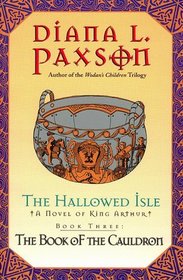From School Library Journal
YA-This series, a vivid four-part retelling of the legend of King Arthur, portrays fifth-century Britain as a tapestry woven from richly multicultural strands. The Book of the Sword and The Book of the Spear (both Avon, 1999) revealed Merlin's secrets and described key episodes in the years of war that established Arthur as High King. Here, several enigmas are addressed, including his failed relationship with Guinevere and his problems with his evil sister (called here Morgause). Often lyrical, with frequent moments of startling beauty, Cauldron places the Old Religion at the center of the story, touching on questions of sexuality and spirituality inherent in the saga-and providing a plausible resolution to some of its mysteries. Fans of Marion Zimmer Bradley's The Mists of Avalon (Del Rey, 1985) can be steered directly to this book (the author acknowledges her debt to Bradley), though the earlier volumes also offer much to interest these readers. Others who are simply intrigued by the classic Arthurian legends, or who are fans of fantasy in general, can also enjoy Paxson's fresh take on the classic tale, but probably should be advised to read the volumes in order. Readers who find themselves confused by the spellings and usages (e.g., Alba for Scotland, Gualchmai for Gawain) can refer to helpful lists of people and places that conclude the book.
YA-This series, a vivid four-part retelling of the legend of King Arthur, portrays fifth-century Britain as a tapestry woven from richly multicultural strands. The Book of the Sword and The Book of the Spear (both Avon, 1999) revealed Merlin's secrets and described key episodes in the years of war that established Arthur as High King. Here, several enigmas are addressed, including his failed relationship with Guinevere and his problems with his evil sister (called here Morgause). Often lyrical, with frequent moments of startling beauty, Cauldron places the Old Religion at the center of the story, touching on questions of sexuality and spirituality inherent in the saga-and providing a plausible resolution to some of its mysteries. Fans of Marion Zimmer Bradley's The Mists of Avalon (Del Rey, 1985) can be steered directly to this book (the author acknowledges her debt to Bradley), though the earlier volumes also offer much to interest these readers. Others who are simply intrigued by the classic Arthurian legends, or who are fans of fantasy in general, can also enjoy Paxson's fresh take on the classic tale, but probably should be advised to read the volumes in order. Readers who find themselves confused by the spellings and usages (e.g., Alba for Scotland, Gualchmai for Gawain) can refer to helpful lists of people and places that conclude the book.




